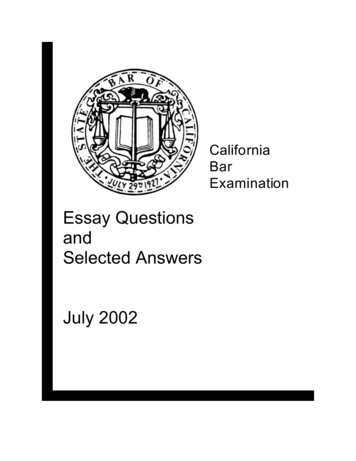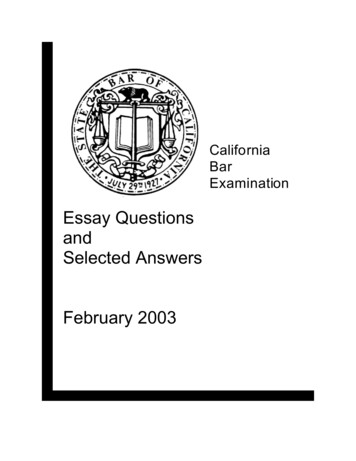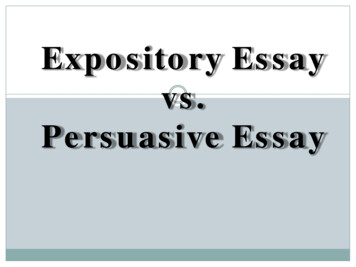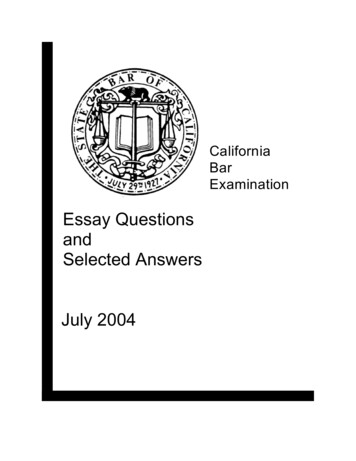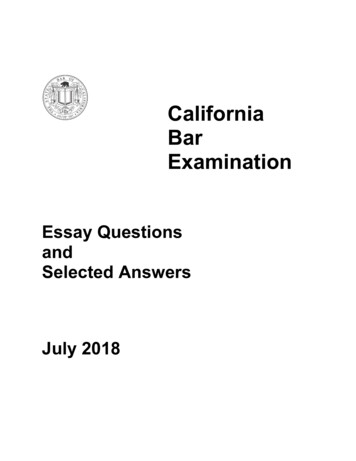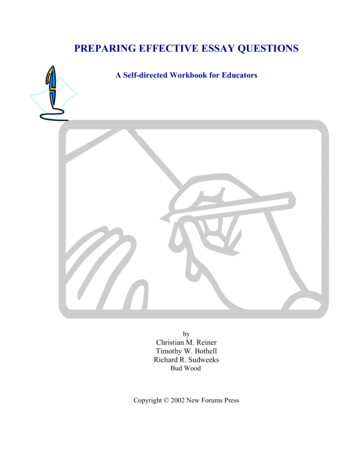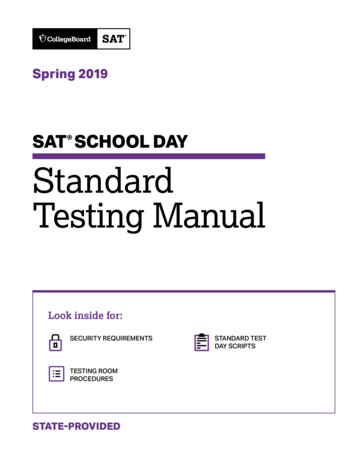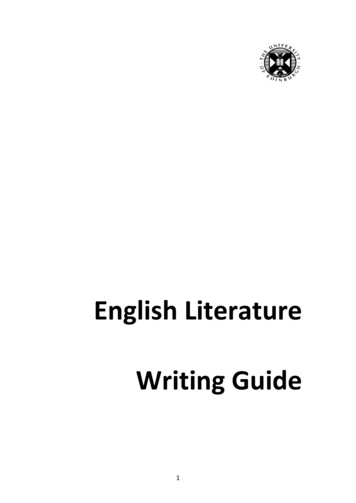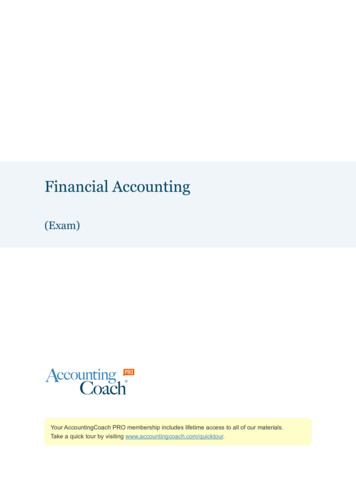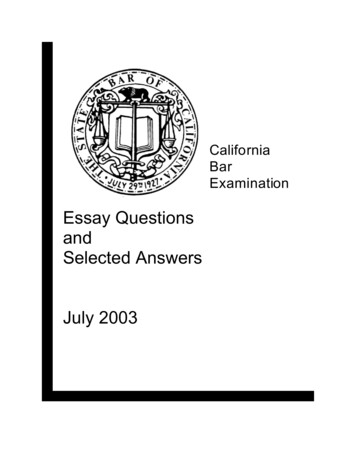
Transcription
CaliforniaBarExaminationEssay QuestionsandSelected AnswersJuly 2003
ESSAY QUESTIONS AND SELECTED ANSWERSJULY 2003 CALIFORNIA BAR EXAMINATIONThis publication contains the six essay questions from the July 2003 California BarExamination and two selected answers to each question.The answers received good grades and were written by applicants who passed theexamination. The answers were prepared by their authors, and were transcribed assubmitted, except that minor corrections in spelling and punctuation were made for easein reading. The answers are reproduced here with the consent of their authors and maynot be reprinted.Question dence184.Torts275.Professional Responsibility426.Wills50i
ESSAY EXAMINATION INSTRUCTIONSYour answer should demonstrate your ability to analyze the facts in the question,to tell the difference between material facts and immaterial facts, and to discern thepoints of law and fact upon which the case turns. Your answer should show that youknow and understand the pertinent principles and theories of law, their qualificationsand limitations, and their relationships to each other.Your answer should evidence your ability to apply the law to the given facts andto reason in a logical, lawyer-like manner from the premises you adopt to a soundconclusion. Do not merely show that you remember legal principles. Instead, try todemonstrate your proficiency in using and applying them.If your answer contains only a statement of your conclusions, you will receivelittle credit. State fully the reasons that support your conclusions, and discuss all pointsthoroughly.Your answer should be complete, but you should not volunteer information ordiscuss legal doctrines which are not pertinent to the solution of the problem.Unless a question expressly asks you to use California law, you should answeraccording to legal theories and principles of general application.ii
Question 1Corp is a publicly held corporation whose stock is registered under Section 12 of theSecurities Exchange Act of 1934. The following sequence of events occurred in 2003:January 2:Corp publicly announced that it expected a 25% revenue increase thisyear.March 1:A Corp director (“Director”) sold 1,000 Corp shares for 25 each.June 15:Corp learned that, because of unforeseen expenses, its revenues woulddecrease by 50% this year, contrary to its January 2 announcement.June 16:A Corp officer (“Officer”) consulted his lawyer (“Lawyer”) for personaltax advice. Officer mentioned, among other things, the probabledevaluation of his Corp stock.June 17:Lawyer telephoned his stockbroker and bought a put option for 1,000 from OptionCo. The put option entitled Lawyer to requireOptionCo to buy 1,000 Corp shares from Lawyer for 20 per share.June 18:Corp publicly announced that its revenues would decrease by 50% thisyear. Its stock price fell from 30 to 5 per share.June 19:Lawyer bought 1,000 Corp shares at 5 per share and required OptionCoto buy the shares for 20,000 pursuant to the put option.July 1:Director bought 1,000 Corp shares for 5 per share.1. In each of the foregoing events, which of the actions by Director, Officer, and Lawyerconstituted a violation of federal securities laws and which did not? Discuss.2. Did Lawyer violate any rules of professional responsibility? Discuss.1
Answer A to Question 1Publicly Held CorporationCorp is a publicly held corporation and is thus subject to federal securities laws. The twolaws at issue in this question are Rule 10(b)5 and Rule 16(b).Director Liability for violating Rule 16(b)Rule 16(b) prohibits a director, officer or 10% shareholder of a publicly traded corporationon a national stock exchange or with assets of over 10,000,000 and 500 shareholdersfrom purchasing and selling or selling and purchasing stock of the corporation in less than6 months. This is deemed short swing trading. The policy behind prohibiting short swingtrading is that short swing trading is against the interests of the corporation.Corp is entitled to recover the maximum difference between an[y] sale and purchase duringthis 6 month period.On these facts, Director sold 1,000 corp shares for 25 each on March 1. Less than 6months later on July 1, director purchased corp shares for 5 per share.The corp is entitled to recover 25- 5 20 multiplied by 1,000 shares or 20,000 dollarsfrom this violation of Rule 16(b).Officer Not Likely Liable for violating Rule 10(b)(5)Rule 10(b)(5) prohibits the use of an instrumentality of inter-state commerce in any schemeto defraud, make material misrepresentations or omissions or in any other way use fraudin the purchase or sale of securities. An insider must either disclose inside information ornot trade in the securities. An insider may also be liable for tipping information regardingthe company for an improper purpose.On these facts, officer had a fiduciary duty to Corp. That duty included not disclosingprivate information regarding Corp. Officer violated his fiduciary duty to Corp when heimproperly mentioned the probable devaluation of Corp stock on June 16th prior to publicdisclosure of this information on June 18th.However, Officer is only liable for a 10(b)(5) violation if he tipped this information to hislawyer for an improper purpose. An improper purpose would be personal gain of Officereither by pecuniary gain or by gifting to Lawyer. It is unclear whether Officer used atelephone to speak with Lawyer or whether he met him in person. Thus, the instrumentalityof inter-state commerce requirement may be lacking as well. The facts tell us that Officerwas seeking tax advice, then he mentioned the devaluation. There is no other indicationof personal gain by Officer resulting from telling Lawyer about the devaluation.2
Officer is not likely liable for tipping for an improper purpose and thus did not violation[sic]Rule 10(b)(5).Lawyer Not Liable under Rule 10(b)(2) but is Liable for MisappropriationA tippee is only liable if the tippee knew that the tipper was giving them non-publicinformation for an improper purpose. As detailed above, it is unlikely that Officer will beliable for tipping for an improper purpose. Thus, Lawyer is not liable under this section.Note that if Officer had an improper purpose, it would be easier to find Lawyer satisfied theother tippee requirements because Lawyer should have known that the information fromOfficer was private information regarding Corp. Lawyer knew that Officer had a duty notto disclose such information. Nonetheless, Lawyer traded on such information.Misappropriation LiabilitySome courts would find that Lawyer is liable for misappropriation of non-public (insider)information in the purchase or sale of securities.Lawyer used the insider information to purchase a put option from Option Co[.] prior to thepublic announcement on June 18th. This bound Option Co. to purchase 1,000 Corp sharesfrom Lawyer at 20 per share. Lawyer then purchased Corp shares at the discounted rateof 5 per share after the public announcement (June 19th). Lawyer profited at 15 pershare multiplied by 1,000 shares 15,000. This 15,000 was ill gotten gain frommisappropriating non-public information about Corp’s revenue decline.2. Lawyer’s Violations of Rules of Professional ResponsibilityLawyer violated the duty of loyalty to Officer, the duty of confidentiality, the duty of care,and engaged in deceitful, dishonest/fraudulent conduct that both negatively reflects onLawyer’s ability to practice law and that harms the dignity of the profession.Duty of CareA lawyer has a duty to act as a reasonable lawyer of ordinary skill, judgment andpreparation. Here, Lawyer’s actions were patently unreasonable. Use of a client’scorporation information fell below the standard of care of a reasonable attorney.Duty of LoyaltyA lawyer has a duty to act in the best interests of the client and not to personally benefit atthe client’s expense. This includes a duty not to self-deal. Lawyer took advantage of abreach of Officer’s fiduciary duty to keep Corp’s information private for personal gain.Lawyer benefitted from the insider trading. Lawyer may also have created professional andlegal liability for his client by using this information. Lawyer breached the duty of loyalty to3
Officer.Duty of Confidentiality/Confidential CommunicationsA lawyer has a duty to keep all communications from his client related to his representationof the client confidential. Courts interpret “related to the representation” quite broadly.Officer consulted Lawyer about personal tax advice. The equity value of Corp may havebeen related to this representation. This includes using any of such confidentialcommunication. As discussed above, Lawyer used such confidential communication to doinsider trading. Lawyer violated his duty to keep Officer’s information confidential.Attorney-Client PrivilegeThe attorney-client privilege is a more narrow evidentiary exception that prevents a courtfrom obtaining information told to a lawyer by his client related to the litigation at issue.Here, there is no pending litigation discussed. Under the ABA rules, an attorney maydisclose confidential communication to prevent a future crime involving death or seriousbodily injury. California does not have a clear exception for death. On these facts, Officer’sstatement regarding Corp’s shares would not likely fall under the attorney-client privilege.Duty Not to Engage in Deceit, Fraud in Personal DealingsA lawyer has a duty not to use deceit or fraud in private dealings. Here, the facts show thatLawyer deceitfully misappropriated insider information and used fraud to obtain a lucrativeoption from Option Co. Lawyer should be subject to discipline for these private acts aswell.Duty to Maintain Dignity of ProfessionA lawyer also has a duty to maintain the dignity of the profession. For all of the reasonsmentioned above, Lawyer violated this duty. A lawyer who acts with deceit and fraud in hisprivate dealings stemming from improperly used information from a client lowers thereputation of the entire profession.4
Answer B to Question 1Director’s ActionsThe Director (“D”) may be liable for violations of federal securities law based on his saleand purchase of 1,000 Corp stocks during 2003. The Corp stock is an equity security, andtherefore, is subject to federal securities laws. There are two bases for D’s liability underfederal securities law: violation of Rule 10B-5 and violation of Section 16B. Please notethat D may also be liable for common law violations of his duty of loyalty as a corporatedirector, but that issue is not to be addressed here.Rule 10B-5 LiabilityRule 10B-5 makes it illegal to use deceit or any fra[u]dulent scheme in connection with thepurchase or sale of a security. Here, the issue is whether D used deceit and/or fraud whenhe sold Corp stock on March 1, and when he bought it at a lower price on July 1.Rule 10B-5 ElementsThe elements of Rule 10B-5 are as follows: (1) use of the instrumentalities of interstatecommerce (which gives the federal government jurisdiction over the transaction); (2) afraudulent scheme or device, which includes (a) misrepresentation of a material fact and(b) insider trading; that is, trading on the basis of material inside information; (3) inconnection with the purchase or sale of a security; (4) with scienter, which must be at leastrecklessness; and (5) reliance by the person on the other side of the transaction, which ispresumed in cases of misrepresentation and insider trading. Any person may be liable forinsider trading, and plaintiffs include both private persons on the other side of thetransaction and the SEC. In addition, “materiality” means that which a reasonable investorwould want to know in making his investment decision.With these elements in mind, I shall assess D’s liability under Rule 10B-5.March 1 SaleD sold 1,000 Corp shares for 25 on March 1. This transaction will fall under thejurisdiction if D used the instrumentalities of interstate commerce, which includes thetelephone, US mails or internet. Here, I will assume that he did so. Note that if D had notused interstate commerce, he could still be liable under state securities laws. In addition,since D actually sold his shares, the transaction is “in connection with a purchase or sale”and, thus, D will be liable if he used fraud or deceit in this sale with necessary scienter.Misrepresentation of a Material Fact. The main issue is whether the Corp’s publicannouncement that it expected a 25% increase in 2003 constituted a misrepresentation ofa material fact for which D may be liable. Surely, an investor would consider it material thatthe revenue increase would not happen, and would instead decline.5
If the corporation recklessly made that announcement in order to pump up its stock price,then D, as a corporate director, would be liable. However, the facts indicate that D sold hisstock on March 1, many months before the Corp learned that its revenues would actuallydecrease by 50% during 2003. In addition, the facts also indicate that the revenuedecrease was due to “unforseen expenses”. If anything, Corp was negligent in making abold revenue prediction that was reversed six months later. Therefore, Corp, and hence,D, did not have the necessary scienter to be liable under Rule 10B-5.Insider Trading. For D to be liable for insider trading, he would have to had traded onmaterial inside information. Since D is a corporate director, he is considered an “insider”.Therefore, he may not trade on material inside information. The critical issue is whetherD possessed any material inside information when he sold his shares on March 1. If D, infact, knew on March 1 that Corp would not have a 25% revenue increase, and thatrevenues would drastically decline, then he may not trade based on that information.Again, the facts indicate that D sold his shares 3 ½ months before the Corp learned thatit would suffer a serious revenue decline, and, thus, probably did not trade on the basis ofinside information. However, if he did suspect that the Corp would not reach its revenuetarget of 25% in his capacity as a corporate insider, then he would be liable under Rule10B-5.July 1 PurchaseOn July 1, D purchased 1,000 Corp shares for 5. Since the revenue decrease of 50% hadbeen publicly and accurately disclosed a few weeks earlier, D is not liable under Rule 10B5.Rule 10B-5 ConclusionBecause the revenue decline was due [to] “unforseen expenses”, D probably did not havematerial inside information, nor possess the necessary scienter to be found liable underRule 10B-5. However, if the court did find him liable, he would have to disgorge his profitsmade or losses averted.Section 16BD may be liable under Section 16B of the ‘34 Act, which holds “insiders”: directors, officersand 10% shareholders, strictly liable, if they make a “profit” on the purchase and sale oftheir corporation’s stock within a 6 month period. Section 16B applies to public companies,that is, ones that are traded on a public exchange and/or meet the number ofstockholders/asset test. Here, Corp is a public company, registered under Section 12 ofthe ‘34 Act, and thus, Section 16B applies to D’s actions.March 1 Sale D was an “insider” when he sold his 1,000 shares of Corp stock for 25/shareon March 1, and, thus, must comply with Section 16B. The facts do not indicate that D6
bought or sold any Corp shares before this date, so I will focus on the subsequenttransaction. If D bought shares within 6 months following this sale for a lower price, thenhe is strictly liable under Rule 16B.July 1 Purchase On July 1, 4 months following his sale of Corp stock, D purchased 1,000shares for 5 per share. Since this occurred within 6 months of his sale, D is strictly liableand must disgorge his “profit.” Here, D’s profit is calculated by the difference between thesale price and purchase price multiplied by the number of shares, which totals 20,000(1,000*(25-5)).Officer LiabilityThe Officer’s (“O”) only action was consulting his Lawyer (“L”) for personal tax advice onJune 16, and mentioning that the value of Corp stock would probably go down, since theCorp had just learned that its revenues would decrease the day before.Rule 10B-5 - TippingThe elements of Rule 10B-5 are discussed above. As indicated, O did not purchase or sellany securities. Instead, the only basis for his liability would be “tipping”. A corporateinsider is liable for “tipping” if he has a fiduciary relationship with the corporation anddiscloses material insider information, at least recklessly, to a “tippee”, who trades on thebasis of that information. Here, O would be the “tipper” and Lawyer would be the “tippee.”A tipper can be liable even if he discloses only to make a gift to the tippee or to enhancehis reputation. A tippee will not be liable unless the tipper is first found liable.O did disclose material insider information to Lawyer, but it does not appear that he did sorecklessly, that he intended to make a gift to Lawyer, or wanted to enhance his reputation.Instead, O consulted L for personal tax reasons. As a client, O had every reason to expectthat L would keep this information confidential. If, however, O disclosed this informationto L to make a gift, use it to pay for legal services, or to enhance his reputation; or if he wasreckless in disclosing this info (by shouting it in a public place), he would be liable.However, the facts indicate that O was careful and confidential in disclosing this info.Therefore, since O was not reckless in disclosing the inside information to L, and [sic]therefore, is not liable under Rule 10B-5.Section 16BAlthough O is an “insider” of a “public company” for Section 16B purchases, since O did notpurchase or sell any securities, he has no liability here.Lawyer LiabilityUnbeknownst to O, L traded on the basis of the material inside information about Corp’s7
unexpected revenue decline that had not been made public as of June 17. On June 17,L bought a “put” option that entitled him to sell Corp shares for 20 per share. Hepresumably did so fraudulently in order to personally benefit from the inside information.The issue, is however, whether he is liable under Rule 10B-5 or Section 16B.Rule 10B-5 L’s liability would be based on his status as “tippee”, since the facts do notindicate that he is an insider of Corp. As discussed above, a tippee is not liable if the tipperis not liable. Since O was not liable as a tipper, L is not prevented from trading on the basisof inside information.Misappropriation theory. The Supreme Court had found non-insiders liable under amisappropriation theory, where the person uses and trades on inside information that heknows or should know is inside info. Here, L clearly knew that it was inside informationsince Corp did not publicly disclose its revised revenue forecast until June 18. Therefore,he could be found liable for the misappropriation theory, and be subject to sanctions by theSEC. He would have to disgorge his profits of 15,000 from the put option, which he madeon June 19, when he purchased shares for 5,000 in toto and sold them for 20,000.The misappropriation theory does not apply to individual actions under rule 10B-5.2. L’s Professional ResponsibilityL violated several rules of professional responsibility when he traded on the insideinformation, including the duty of confidentiality, duty of loyalty, duty of fairness and dutyto uphold the law.Duty of confidentialityA lawyer may not use or reveal anything learned in the course of representing his clientwithout the client’s consent. Here, O was L’s client, who revealed confidential informationto L about the possible devaluation of Corp stock. O did not consent for L to use thisinformation or reveal it to anyone. Although it does not appear that L revealed thisinformation, he certainly used it and therefore, violated the duty of confidentiality. Heshould not have traded on this information.Duty of loyaltyA lawyer also owes a duty of loyalty to his client, and may not let personal interests, or the3rd party or other client interfere with his representation of his client. Here, there is a conflictof interest between O and L. L may not use O’s confidential information for his own benefit,which L did so when he purchased the put option.Duty of Fairness/CandorA lawyer also owes a duty of fairness and candor to the public and 3rd parties. Here, L8
violated that duty by “misappropriating” the inside information and trading on it to his ownadvantage. By using this info, he acted unfairly to OptionCo, forcing it into a bad deal.Duty to Uphold the LawA lawyer also has a duty to uphold the law. Here, L violated the laws of securities tradingand committed several breaches of his ethical duties when he used inside information. Ifhe were in California, he would be required to “self-report” this fraudulent activity.9
Question 2In 1993, Polly and Donald orally agreed to jointly purchase a house on Willow Avenue.They each contributed 20,000 toward the down payment and jointly borrowed the balanceof the purchase price from a bank, which took a first deed of trust on the property assecurity for the loan. Polly paid her 20,000 share of the down payment in cash. Donaldpaid his 20,000 with money he embezzled from his employer, Acme Co (Acme).Polly and Donald orally agreed that the house would be put in Donald’s name alone. Pollyhad creditors seeking to enforce debt judgments against her, and she did not want themto levy on her interest in the house. Polly and Donald further orally agreed that Donaldalone would occupy the property and that, in lieu of rent, he would make the monthly loanpayments and take care of minor maintenance. They also orally agreed that if and whenDonald vacated the property, they would sell it and divide the net proceeds equally.Donald lived in the house, made the monthly loan payments, and performed routinemaintenance.In 1997, Acme discovered Donald’s embezzlement and fired him.In 1998, Donald vacated the house and rented it to tenants for three years, using the rentalpayments to cover the loan payments and the maintenance costs.In 2003, Donald sold the house, paid the bank loan in full, and realized 100,000 in netproceeds. Donald has offered to repay Polly only her 20,000 down payment, but Pollyclaims she is entitled to 50,000.Having made no prior effort to pursue Donald for his embezzlement, Acme now claims itis entitled to recover an amount up to the 100,000 net proceeds from the sale of theproperty, but, in any case, at least the 20,000 Donald embezzled. Donald has no assetsapart from the house sale proceeds.What remedies, based on trust theories, might Polly and Acme seek against Donald as tothe house sale proceeds, what defenses might Donald reasonably assert against Polly andAcme, and what is the likely result as to each remedy? Discuss.10
Answer A to Question 2Polly’s Remedies Against DonaldConstructive TrustA constructive trust, an equitable remedy, is a court-ordered obligation for one party whohas been unjustly enriched at the expense of another to return the relevant property orassets to the injured party. To be entitled to an equitable remedy, a plaintiff must show thatall legal remedies are inadequate. One of the situations in which a constructive trust hasbeen used as a remedy by courts is that of an invalid oral agreement (i.e., oneunenforceable at law) that is induced by fraud. Here, Polly and Donald entered into an oralagreement concerning the house they purchased together. Any agreement concerning theland must comply with the Statute of Frauds. Because the agreement between Polly andDonald was oral, it violated the Statute of Frauds [and] is therefore unenforceable at law.However, Polly can successfully argue that the agreement was induced by Donald’s fraud.It appears from the facts that Donald made the oral promise to equally split proceeds fromthe sale of the house in order to get Polly to put up 20,000 for the down payment and thathe never planned to abide by this agreement. When Donald ultimately sold the house for 100,000, he reneged on the agreement he had made with Polly, offering Polly her initialinvestment of 20,000. This resulted in unjust enrichment to Donald. Finally, Donald hasno assets apart from the house sale proceeds. Where a defendant is insolvent, damagesare not available and a court will look to equitable remedies such as a constructive trust.Because of Donald’s fraud, unjust enrichment at Polly’s expense, and insolvency, a courtcould feasibly impose a constructive trust on half of the proceeds from the sale of thehouse in favor of Polly.Purchase Money Resulting TrustWhere one party has provided all or part of the consideration for purchase of property, buttitle to the property is taken in another party’s name, a resulting trust will be imposed infavor of the party that has provided the consideration. Where the title holding party sellsthe property to a third party, the party providing consideration may impose a resulting truston the consideration the title-holder received in exchange for the property. Here, Pollysupplied half of the downpayment for purchase of the house, but title was taken in Donald’sname only. Therefore, half of the house was held in a purchase money resulting trust forPolly. When Donald sold the house, half of the consideration he received for it ( 100,000)would be subject to a resulting trust of which Polly is beneficiary. Polly would therefore beable to prevail on a purchase money resulting trust theory as well.Donald’s DefensesDonald could assert a number of equitable defenses to the equitable remedy ofconstructive trust.11
Unclean HandsThe unclean hands defense asserts that the plaintiff should not be entitled to equitybecause she herself has engaged in a wrong in the transaction for which she claims injury.Here, Donald could claim that Polly’s having creditors seeking to enforce debt judgmentsagainst her, and thereby asking Donald to put the house entirely in his name, constitutedunclean hands. However, Polly’s debt issues are unrelated to Donald’s fraudulent conduct.There is no suggestion that Polly engaged in any wrongful conduct in her dealings withDonald. Therefore, this defense will likely fail.LachesThe laches defense asserts that a plaintiff cannot bring an action once an unreasonableamount of time has passed after the injury and the delay has somehow prejudiced thedefendant. Here, Donald will argue that he and Polly had agreed that, upon Donald’svacating the house, the property would be sold and the net proceeds divided equally.Donald vacated the house in 1998. However, at that time, Polly did not insist on the housebeing sold. After renting the house for five years, Donald finally sold it in 2003. Donald willargue that Polly’s claim was actionable in 1998, but that she waited five years beforebringing it. Donald will argue that five years is an unreasonable amount of time to waitbefore bringing the lawsuit and that he will be prejudiced by the delay. However, Polly canargue that the substantial part of the injury to her was sustained not in 1998, when Donaldvacated the house and did not immediately sell it, but in 2003, when Donald sold the houseand withheld Polly’s rightful half share of the proceeds. This agreement will be successful,as Polly did not sustain a sustainable financial injury until Donald’s 2003 withholding of thesale proceeds. Therefore, Donald is unlikely to prevail in establishing the laches defense.Acme’s Remedies Against DonaldConstructive TrustAcme could seek the imposition of a constructive trust on Donald’s proceeds from the saleof the house. Where a party has obtained property through fraudulent conduct, courts willimpose a constructive trust on the defrauding party’s property to prevent unjust enrichment.Here, Donald used funds he had embezzled from Acme to purchase the house and wasthereby unjustly enriched. Aside from the proceeds from the sale of the house, Donald isinsolvent. Therefore, a court could rightfully impose a constructive trust on Donald’s halfof the proceeds from the sale of the house.One issue is whether the constructive trust would be imposed only to the extent of the 20,000 Donald embezzled from Acme or to the extent that Donald benefitted from theembezzlement, i.e., the full amount (or at least his half share) of the proceeds from thesale. Where a party is unjustly enriched at another’s expense, restitution will be in theamount of the benefit to the unjustly enriched party. Because Donald benefitted at least 50,000 from the sale of the house, and because this benefit would not have been possible12
without the 20,000 Donald initially embezzled from Acme, Acme will be entitled toDonald’s half share in the net proceeds from the sale of the house. Acme is not entitledto the full 100,000, however, since this would lead to an inequitable result for Polly, whoput up half of the downpayment and entered into an agreement with Donald for half of theproceeds.Purchase Money Resulting TrustAcme could also assert the remedy of purchase money resulting trust. Here, Acmeunknowingly provided the consideration for Donald’s purchase of the house. Title to thehouse was taken in Donald’s name only. Donald therefore held his interest in the housein resulting trust with Acme as the beneficiary. When Donald sold the house, one half ofthe consideration Donald received would likewise be held in a resulting trust with Acme asthe beneficiary. A court would likely award this remedy to Acme.Donald’s DefensesUnclean HandsThere is no plausible basis on which to assert that Acme had unclean hands. To thecontrary, Donald embezzled funds from Acme. Acme was a victim of Donald’s fraud andperpetrated no fraud of its own.LachesDonald will assert that, because Acme discovered Donald’s embezzlement in 1997 but didnot bring the action until 2003, that th
This publication contains the six essay questions from the July 2003 California Bar Examination and two selected answers to each question. The answers received good grades and were written by applicants who passed the examination. The answers were prepared by their authors, and were transcribed as
